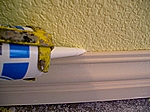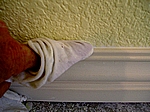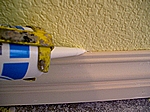Professional Results Come From Using the Right Caulking Materials and Techniques
When you fill all the cracks and gaps in between the trim and the walls, your paint job will really look professional. The before and after pictures below demonstrate just how dramatic an improvement interior caulking make in the final appearance of any painted surface.
The objective is to fill every crack in the trim and every gap between the walls and the trim. Most painted trim is usually painted white or off-white. Dark cracks show! Filling these cracks will produce a very desirable, finished look.
Choose the Right Caulk
Siliconized acrylic caulk and elasomeric caulk work great. These two types of caulking are easy to tool, dry quickly, readily accept paint. Best of all clean up involves only warm water. Carefully read the product label to be sure it is paintable and will be suitable for your needs.
Don’t skimp on quality. High quality sealants only cost slightly more per tube, but the results will last a very long time.
Use a Good Caulking Gun
The caulking gun is as important as the caulk. Choosing a good caulking gun will make this task a lot easier and more enjoyable. It is very hard to produce professional looking results if you use a cheap caulking gun. It’s not price as much as type of gun that matters.
Learn How to Use a Caulking Gun
Using a caulking gun is very simple. Cut the plastic tip to the size you want the bead of caulk to be. A razor knife, held at a 45-degree angle, works very well.
At first, use the smallest size hole possible. No need to waste the caulk and create a mess. An 1/8-inch hole usually works best. Don’t start with a large hole. Cutting more of the plastic tip can increase the thickness of the bead.
If the tube has an inner foil seal, puncture with a thin piece of wire several times. A nail works very well also.
How to Apply Caulk to a Crack or Gap
Many cracks and gaps will need filling. The best approach is to use a fluid motion with the least amount of pressure on the trigger.
 Hold the gun with the tip flat against the crack and pull towards you. Remember to use the smallest pressure on the trigger necessary to lay down a uniform bead. With practice this will become easier.
Hold the gun with the tip flat against the crack and pull towards you. Remember to use the smallest pressure on the trigger necessary to lay down a uniform bead. With practice this will become easier.
Now run your finger the length of the bead to press the sealant into the crack and smooth the transition between the trim pieces. For an even smoother look use a soft, damp rag over your finger while smoothing the sealant. This step is called “tooling.”
Remember to rinse often and frequently change the position of the rag on your finger. Have a gallon bucket with clean, warm water nearby.
 This method works great if the right amount is applied. If too much caulk is applied, you will have to work quickly to remove the excess and smooth the bead.
This method works great if the right amount is applied. If too much caulk is applied, you will have to work quickly to remove the excess and smooth the bead.
Most sealants dry very quickly. You must work at a brisk speed. After just 2-3 minutes the thin edges of caulk will have dried and will be very difficult to smooth out.
To learn more about applying caulk, see Interior Caulking Tips.


2 Responses
I have a bathroom remodeling project that will require painting some tile board paneling…do you have a recommendation on caulking that will take the water based acrylic paint or epoxy based paints recommended for tile board ?
A standard siliconized-acrylic will work. But for a better seal consider a urethane caulking like Sherwin Williams SherMax Urethanized Elastomeric Sealant or Big Stretch. Check with your local paint store for options.